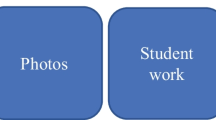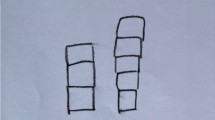Abstract
In this study, 34 children were evaluated in order to elucidate their multiplicative thinking and interpretation of the area formula of a rectangle, and to determine what roles these factors play in solving area measurement problems. One-on-one interviews and problem-solving tasks were employed to explore the problem-solving skills of the children regarding these two concepts. This study also explored how the associations changed throughout two consecutive phases, from the third to the fourth grades. The results indicated that in the third grade, multiplicative thinking was associated with the solving of area measurement problems. Third-grade children who understood the meaning of the multiplication symbol “p × q” in models (e.g., the set model and arrays) outperformed children who understood only partial multiplicative concepts or additive thinking; however, the association between multiplicative thinking and solving area measurement problems was not significant in the fourth grade. In contrast, children’s ability to interpret the area formula of a rectangle was associated with their performance at solving area measurement problems throughout the third and fourth grades. The way of interpreting the area formula was associated with the extent to which the children understood multiplication, area measurement, and the spatial concepts embedded in rectangular figures. The instructional implications of the study are discussed in terms of developing child abilities to solve area measurement problems by connecting multiplication and area measurement.
Similar content being viewed by others
References
Askew, M., Hodgen, J., Lossain, S., & Bretscher, N. (2010). Values and variables: Mathematics education in high-performing countries. London: Nuffield Foundation. http://www.nuffieldfoundation.org/values-and-variables-mathematics-education-high-performing-countries. Accessed 10 June 2014.
Carpenter, T. P., Fennema, E., Franke, M. L., Levi, L., & Empson, S. B. (1999). Children’s mathematics: Cognitively guided instruction. Reston, VA: National Council of Teachers of Mathematics.
Clark, F., & Kamii, C. (1996). Identification of multiplicative thinking in children in grades 1–5. Journal for Research in Mathematics Education, 27(1), 41–51.
De Bock, D., Van Dooren, W., Janssens, D., & Verschaffel, L. (2002). Improper use of linear reasoning: an in-depth study of the nature and the irresistibility of secondary school students’ errors. Educational Studies in Mathematics, 50, 311–334.
Department for Education (2013). Statutory guidance. National curriculum in England: Mathematics programmes of study. https://www.gov.uk/government/publications/national-curriculum-in-england-mathematics-programmes-of-study. Accessed 10 June 2014.
Fellows, N. J. (1994). A window into thinking: Using student writing to understand conceptual change in science learning. Journal of Research in Science Teaching, 31(9), 985–1001.
Fischbein, E., Deri, M., Nello, M. S., & Marino, M. S. (1985). The role of implicit models in solving verbal problems in multiplication and division. Journal for Research in Mathematics Education, 16(1), 3–17.
Fuys, D., Geddes, D., & Tischler, R. (1988). The van Hiele model of thinking in geometry among adolescents. Journal for Research in Mathematics Education, Monograph, 3, 1–195.
Greer, B. (1992). Multiplication and division as models of situations. In D. A. Grouws (Ed.), Handbook of research on mathematics teaching and learning (pp. 276–295). New York: Macmillan.
Hino, K. (2002). Acquiring new uses of multiplication through classroom teaching: an exploratory study. Journal of Mathematical Behavior, 20, 477–502.
Huang, H.-M. E., & Witz, K. G. (2011). Developing children’s conceptual understanding of area measurement: A curriculum and teaching experiment. Learning and Instruction, 21(1), 1–13.
Huang, H.-M. E., & Witz, K. G. (2013). Children’s conceptions of area measurement and their strategies for solving area measurement problems. Journal of Curriculum and Teaching, 2(1), 10–26.
Izsák, A. (2005). “You have to count the squares” applying knowledge in pieces to learning rectangular area. The Journal of the Learning Science, 14(3), 361–403.
Lin, P.-J., & Tsai, W.-H. (2003). Fourth-graders’ achievement of mathematics in TIMSS 2003 field test (in Chinese). Science Education Monthly, 258, 2–20.
National Council of Teachers of Mathematics. (2006). Curriculum focal points for prekindergarten through grade 8 mathematics: A quest for coherence. Reston, VA: Author.
NCTM Research Committee. (2014). The NCTM research presession: A brief history and reflection. Journal for Research in Mathematics Education, 45(2), 157–172.
Nunes, T., Bryant, P., Burman, D., Bell, D., Evans, D., & Hallett, D. (2009). Deaf children’s informal knowledge of multiplicative reasoning. Journal of Deaf Studies and Deaf Education, 14(2), 260–277. http://jdsde.oxfordjournals.org/content/14/2/260.short. Accessed 26 May 2014.
Outhred, L. N., & Mitchelmore, M. C. (2000). Young children’s intuitive understanding of rectangular area measurement. Journal for Research in Mathematics Education, 31(2), 144–167.
Park, J.-H., & Nunes, T. (2001). The development of the concept of multiplication. Cognitive Development, 16, 763–773.
Rittle-Johnson, B. (2006). Promoting transfer: Effects of self-explanation and direct instruction. Child Development, 77(1), 1–15.
Sarama, J., & Clements, D. H. (2009). Early childhood mathematics education research: Learning trajectories for young children. New York: Routledge.
Schifter, D., & Szymaszek, J. (2003). Structuring a rectangle: Teachers write to learn about their students’ thinking. In D. H. Clements & G. Bright (Eds.), Learning and teaching measurement: 2003 Year book (pp. 143–156). Reston, VA: National Council of Teachers of Mathematics.
Siemon, D., Izard, J., Breed, M., & Virgona, J. (2006). The derivation of a learning assessment framework for multiplicative thinking. In J. Novotná, H. Moraová, M. Krátká, & N. Stehliková (Eds.), Proceedings of the 30th Conference of the International Group for the Psychology of Mathematics Education, 5, pp. 113–120.
Stephan, M., & Clements, D. H. (2003). Linear and area measurement in prekindergarten to grade 2. In D. H. Clements & G. Bright (Eds.), Learning and teaching measurement: 2003 Yearbook (pp. 3–16). Reston, VA: National Council of Teachers of Mathematics.
Taiwan Ministry of Education (2010). Grade 1–9 curriculum for junior high school and elementary school: Mathematics (3rd ed.) (in Chinese). Taipei, Taiwan: Author.
Acknowledgments
This study was supported, in part, by research grant [NSC99-2511-S-133-006] from the National Science Council (NSC) in Taiwan. The opinions expressed in this paper do not necessarily reflect the views of NSC. This study was carried out with the assistance of Wen-Hou Chang, an elementary school teacher. Her assistance is gratefully acknowledged. I greatly appreciate the three reviewers’ insightful comments and valuable suggestions on earlier drafts. I also thank the students who participated in this study.
Author information
Authors and Affiliations
Corresponding author
Rights and permissions
About this article
Cite this article
Huang, HM.E. Third- to fourth-grade students’ conceptions of multiplication and area measurement. ZDM Mathematics Education 46, 449–463 (2014). https://doi.org/10.1007/s11858-014-0603-1
Accepted:
Published:
Issue Date:
DOI: https://doi.org/10.1007/s11858-014-0603-1




